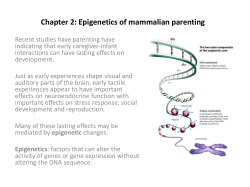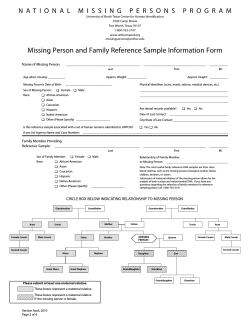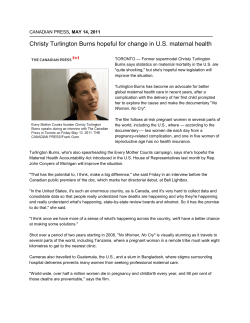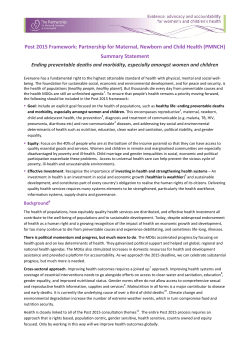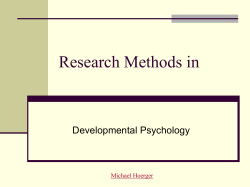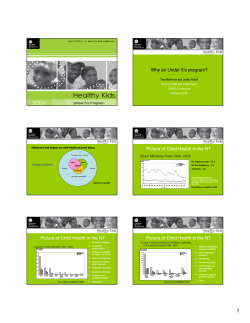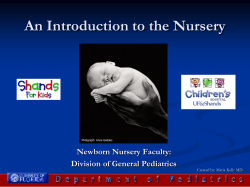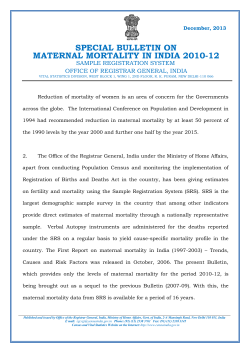
DOHaD
Political and Policy Implications for non-communicable Disease prevention – the DOHaD perspective Sir Peter Gluckman FRS Paris May 2012 Chief Science Advisor to the Prime Minister of New Zealand Evidence does not make policy – it is an input into policy • Policy is a ma:er of poli=cal compromise driven by the con=ngencies of the cons=tuencies of the policy maker. • In general there is an inevitable tension between short-‐term electoral considera=ons and longer-‐term goals. • Policy is primarily the art of seeking a solu=on to a range of inputs – most of which have a strong values component – – – – – – – Communal values Conventional wisdom Public option Cost/benefit, magnitude of effect, timeline Fiscal considerations and competing interests Diplomatic considerations Political ideology and electoral considerations • In recent years there has been a gradual move to place scien=fic knowledge in a privileged place in policy forma=on – namely to try and separate it from values dimensions So where does science fit in to policy forma:on? • In recent years there has been a gradual move to place scien=fic knowledge in a privileged place in policy forma=on – namely to try and separate it from values dimensions • If science is presented in a value laden way then it will be treated no differently to any other input (issues advocacy) • If science can be presented in a largely values free way then it can play a privileged role in policy forma=on (honest brokerage) • But in many cases – The science will be incomplete but ac=ons are needed – There will be inferen=al gaps between the science and decisions that must be made by policy makers – The key issue is what are the consequences of error in that inference – Science advice must be honest about those issues Steps in knowledge transfer to policy –the DOHaD (nutri:on/stress) story New knowledge from science • Epidemiological, cliniial and experimental data • Higgins et al 1980 • Wadsworth, Gensser 1987 • Barker’s group 1988 • The evidence from epigene=cs • Godfrey et al 2011 • Evolu=onary arguments 2004 • Bateson 2004 • Gluckman and Hanson 2004 Mismatch and Non-‐Communicable disease • There is no doubt that the nutritional transition is an evolutionary novelty • There can have been no selection for the nutritional ranges we now live with and it is unrealistic to imagine that we will return to those • Life spans have increased enormously • As nutritional loads increase more individuals will exceed their metabolic adaptive capacity • Those most sensitive to the obesogenic environment are most likely to exceed their metabolic adaptive capacity - this will be reflected in type two diabetes etc. Variable vulnerability Central obesity and insulin resistance in South Asians • We all now live in obesogenic and the (mU/l) realistic 2h insulin asting insulinenvironments (mU/l) Diabetes prevalence (%) level of change in the 15 30 environment possible will not 50 take many people (at least in S.Asian Asia) below the point of 40 metabolic compromise 10 20 Indian 30 • There is considerable individual and population 20 variation in European sensitivity : why? 5 10 UK 10 0 3 4 5 6 Fasting glucose 7 0 0.8 0.9 1 0 0.8 Waist / hip ratio From Mckeigue et al. Lancet, 1991, 337: 382 0.9 1 Waist / hip ratio GUSTO: Ethnicity & GDM " For a given birth weight, Indian neonates have greater deep & superficial subcutaneous abdominal adipose tissue depots than Chinese and Malay neonates. " The ethnic differences in adipose tissue depots are greatest in the highest tertile BW group " Neonates of mothers with GDM have greater deep subcutaneous abdominal adipose tissue " Disproportionate Abdominal Adipose Tissue deposition in first 6 weeks of life, but not between 6 weeks & 6 months where it was proportional to body size. " Chinese babies started with lesser adipose tissue but put on greatest fat " Tint, Chong, Gluckman et al in prepara5on Prenatal state affects appetite set-point in adulthood Marasmic survivors r= 0.19 p<0.05 Kawashiokor survivors r= 0.26 P<0.05 Corrected for gender, current LBM Raubenheimer, Forrester, Gluckman et al in preparation Increasing evidence of developmental epigenetic influences on phenotypic outcomes even in the normative range of experiences Epigenetic state at birth predicts body composition in childhood Child’s fat mass (kg) 8.0 PAH children 9 y SWS children 6 r=0.47, P=0.014 n=27 r=0.32, P=0.009 n=64 r=0.20, P=0.002 n=239 8.0 Variance explained: 7.0 7.0 6.0 6.0 5.0 5.0 4.0 4.0 3.0 3.0 2-35% -59% Godfrey et al Diabetes 2011 -84% -100% least likelihood ~ 40% -63% -73% -80% Umbilical cord RXRA Methylation CpG 2/13 -100% Values are means + SEM Low maternal carbohydrate intake in early pregnancy associated with higher RXRA gene promoter methylation 80 r=-0.26, P=0.027, n=64 70 Umbilical cord RXRA: methylation CpG 2/13 60 50 40 Lowest Godfrey et al Diabetes 2011 2nd 3rd Highest Maternal carbohydrate intake in early pregnancy (quartiles) N.B. No association with mother’s BMI or offspring birthweight Women with a lower level of educational attainment are more likely to eat an unbalanced “imprudent” diet 60% 50% % in the lowest quarter of prudent diet score 40% 55% 49% 34% 30% 19% 20% 13% 10% 4% 0% Educational level EJCN 2004; 58:1174-80 The subtlety of developmental influences Parity p=0.004 Mother’s BMI in early pregnancy p<0.001 35.0 % body fat at 28-31 years Primiparous Multiparous 30.0 Epigenetic differences present at birth in first born in Singapore 25.0 -21.5 -24.2 >24.15 Mother’s body mass index in early pregnancy (kg/m2 ) Godfrey et al – JCEM 2010 Adjusted for age, sex & current smoking Factors to consider in explaining the high risk of non-‐communicable disease in Asia • Rapid socioeconomic and nutritional transitions • Genetic variation ?? • Developmental factors – Maternal undernutrition – global, specific micronutrients 10-60%) – Lack of girls education/ womens’ empowerment – in some countries – Maternal workloads – Indian subcontinent – Maternal stunting – severe maternal constraint – (40% Indonesia) – Demographic change – the single child – China (75%) – Gestational diabetes – China, India, Singapore (25%) – Maternal obesity – growing (5-10%) The opportunities and challenges of epigenetic biology • Provides mechanistic basis • Provides evidence of magnitude of effect • Allows us to resolve many unknowns about maternal state effects • Allows intervention optimization • But • Any physiological event in development may have epigenetic effects as developmental plasticity is normative • How will we distinguish a potential pathophysiological effect from a physiological effect • Epigenetic change alone may thus not be enough to induce precaution The role of epigene:cs Epigene=c state at birth can predict later phenotypic outcome (independent of birth weight) For candidate genes, methyla=on Umbilical explains a significant part of the cord variance in later phenotype eNOS CpG9 methylation (%) Epigene=c profile at birth is related to aspects of developmental nutri=on Epigene=c measurements at birth or soon aZer can be use to define nutri=onal outcome 11.0 10.0 r = 0.27 P = 0.027 9.0 8.0 -20.0 -26.5 -35.0 Mother’s early pregnancy meat intake (g/day) >35 Steps in knowledge transfer to policy New knowledge from science Accepted scien=fic posi=on • The challenges of gene=c determinism • The focus on life-‐style determinism in adults • The failure to recognise the developmental sources of individual varia=on in vulnerability NCD prevention Is focused on proximate rather than ultimate prevention Treated as a medical rather than a human capital issue WHO as lead agency NCDs are caused, to a large extent, by four behavioural risk factors that are pervasive aspects of economic transition, rapid urbanization and 21st-century life: tobacco use, unhealthy diet, insufficient physical activity and the harmful use of alcohol. There was no meaningful reference to development A focus on individual life style choice as adults as the primary focus is not tenable • Life style approaches do not work well for those most at risk – Knowledge (health literacy), =me preference and mo=va=on, cultural and sociological reasons – Obesity and NCDs do not have one to one rela=onship • People have a variable response to an obesogenic environment o Evolu=onary reasons – body weight is defended, =me preferences are short for those at risk o Differen=al sensi=vity – gene=c o Differen:al sensi:vity -‐ epigene:c/programming o Epigene:c inheritance – direct and indirect o Developmental hard wiring of appe:te control, res:ng energy expenditure, willingness to exercise o Developmental set points for body weight control DOHAD – difficul:es in overcoming conven:onal wisdom • Six major issues have delayed acceptance of the DOHAD model – Gene=c determinism, – The focus on birth weight – The need for a biologically plausible mechanism – Demonstra=ng the importance of the process – Demonstra=ng the weight of its effect – It is not addressable – All these issues have been addressed • It is not explained by GWAS • It is not about birth weight • It involves epigene=cs • Development is cri=cal • There are clear points of interven=on Steps in knowledge transfer to policy New knowledge from science Accepted scien=fic posi=on • The DOHaD approach largely fits with a “folk biology” model of nurture during pregnancy • But focus on empowerment of women may clash with some cultural views Public understanding and acceptance Culture and mores Steps in knowledge transfer to policy New knowledge from science • Cost benefit? Accepted scien=fic posi=on Cost/benefit The treasury view • Rela=vi=es? • The problem of life course discoun=ng Public understanding and acceptance Culture and mores Persuading Treasury Need a clear demonstra=on of the value proposi=on that improving the start to life can: • • • • • • • • Reduce infant and child mortality Reduce burden on families Reduce costs of neonatal health care Reduce costs of health care for children Improve progress through adolescence Increase produc=vity by reducing stun=ng Increase produc=vity by increasing cogni=ve ability Reduce costs of chronic diseases • Improve the health of next genera=on Steps in knowledge transfer to policy New knowledge from science Public Accepted understanding scien=fic and posi=on The poli=cal agenda acceptance Cost/benefit The treasury view Ideology Poli=cal priori=es, vo=ng cycles, public opinion, vested interests Culture and mores The most important political and scientific question: Whose fault is it? To what extent are NCDs a ma:er of voluntary behaviour? To what extent are NCDs hardwired? The answer determines the poli=cal and policy responses • If the problems is presented as “sloth and gluttony” and as a “adult choice problem” (the traditional NCD argument) it invites the passive response by the State as a matter of individual responsibility. This is particularly so with respect to interventions in children (“the nanny state”). • If the problem is presented as a combination of both individual and population vulnerabilities where many factors are not the fault of the individual (the DOHAD argument) and if the focus is shifted from dogma to evidence based interventions, then rational economic arguments for public intervention become possible irrespective of ideology. DOHaD and policy formation • There is not a magic bullet single interven=on • The interven=ons are soZ and fuzzy and not well developed or validated • A shiZ to ul=mate rather than proximate cause more likely to be effec=ve – there are logical strategies to test – there are tools for (short-‐term) valida=on – Needs to be integrated with other outcomes Points of intervention • • • • • • • Preconception Periconceptual Early pregnancy Late pregnancy Lactation Weaning Childhood Linkage to other agendas • The DOHAD agenda is not isolated and will not be effec=ve in isola=on • The outcomes are not isolated • The interven=on logic and nature of interven=ons are not isolated • • • • • Maternal and infant survival (MDG 4,5) Prematurity and IUGR Cogni=ve development Allergy preven=on Behavioral development A more realistic set of outcomes • Understand that our individual sensi=vity to living in the obesogenic world depends primarily on our biology including behaviours set early in life. • Recognise that preven=on in adulthood will have limited success in isola=on • Con=nue to promote healthy ea=ng, exercise and a:ack smoking but accept long-‐term treatment of morbid obesity and NCDs is based on surgery and high cost medicines • Give priority to human capital development – Women’s empowerment, educa=on, nutri=onal literacy • Give priority to life course development – Maternal and infant nutri=on/health, breast feeding, weaning and infancy • Partner with the food industry • Establish a mul=agency approach United Na:ons (Sept 2011): Poli:cal declara:on of the High-‐level Mee:ng of the General Assembly on the Preven:on & Control of Non-‐communicable Diseases Note also with concern that maternal and child health is inextricably linked with NCDs and their risk factors, specifically as prenatal malnutri=on and low birth weight create a predisposi=on to obesity, high blood pressure, heart disease and diabetes later in life; and that pregnancy condi=ons, such as maternal obesity and gesta=onal diabetes, are associated with similar risks in both the mother and her offspring Clause 26 Policy agenda • Several governments have publically committed to a focus in this area and are working towards packaged interventions – eg NZ, Scotland, Wales – USA: 1000 days • UNDP has taken up the challenge for developing countries • WHO has been largely silent, remaining focused on tertiary prevention • WHO targets has no reference to maternal and child factors • DOHAD 2013 is being designed specifically to bring the parties together th – Public sector – Private sector – NGOs – Researchers – Developed and developing world focus 8 World Congress DOHaD November 17-20 2013 SINGAPORE
© Copyright 2025
